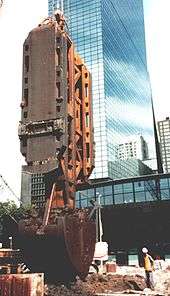Slurry wall

A slurry wall is a civil engineering technique used to build reinforced concrete walls in areas of soft earth close to open water, or with a high groundwater table.[1] This technique is typically used to build diaphragm (water-blocking) walls surrounding tunnels and open cuts, and to lay foundations.
Construction
While a trench is excavated to create a form for a wall, it is simultaneously filled with slurry (usually a mixture of bentonite and water). The dense but liquid slurry prevents the trench from collapsing by providing outward pressure, which balances the inward hydraulic forces and also retards water flow into the trench.
Slurry walls are typically constructed by starting with a set of guide walls, typically 1 metre (3 ft 3 in) deep and 0.5 metres (1 ft 8 in) thick. The guide walls are constructed on the ground surface to outline the desired slurry trench and guide the excavation machinery. Excavation is done using a special clamshell-shaped digger or a hydromill trench cutter, suspended from a crane. The excavator digs down to design depth (or bedrock) for the first wall segment. The excavator is then lifted and moved along the trench guide walls to continue the trench with successive cuts as needed. The trench is at all times kept filled with slurry to prevent its collapse, but the liquid filling allows the excavation machinery and excavation spoil to be moved without hindrance.
Once a particular length of trench is reached, a reinforcing cage is lowered into the slurry-filled pit and the pit is filled with concrete from the bottom up using tremie pipes. The heavier concrete displaces the bentonite slurry, which is pumped out, filtered, and stored in tanks for use in the next wall segment, or recycled.
Slurry walls are successively extended to enclose an area, blocking water and softened earth from flowing into it. Once the concrete has hardened, excavation within the now concrete-wall-enclosed area can proceed. To prevent the concrete wall from collapsing into the newly open area, temporary supports such as tiebacks or internal crossbeams are installed. When completed, the structure built within the walled-off area supports the wall, so that tiebacks or other temporary bracing may be removed. Stability of the trench is essential in trench cutting. Usage of bentonite with precise density prevents collapse of trench walls
History
The slurry wall technique was first introduced during the excavation of Line 1 on the underground rapid transit system of Milan, Italy by the company ICOS (Impresa Costruzioni Opere Specializzate) just after the end of World War II. This new technology became an important component of the top-down tunnelling method also known as Metodo Milano ("Milan method").[2]
Slurry wall construction was used to construct the "bathtub" that surrounded the foundations of most of the World Trade Center site in New York City.[3] In the 1980s, the Red Line Northwest Extension project in Boston was one of the first projects in the US to use the modern form of the technology, with hydromill trench cutters and the "Milan method". Slurry walls were also used extensively in Boston's later Big Dig tunnel project.
See also
References
- ↑ Gutberle (1994). "Slurry Walls". Virginia Tech. Archived from the original on 2012-01-05. Retrieved 2012-01-05.
- ↑ "Primo by Ex Libris -". Retrieved 2015-08-25.
- ↑ David W. Dunlap (September 11, 2013). "Looking to a Wall That Limited the World Trade Center's Devastation". New York Times. Retrieved September 11, 2013.
A portion of the slurry wall was deliberately left exposed in the Foundation Hall of the National September 11 Memorial Museum, set to open next year.
External links
| Wikimedia Commons has media related to Slurry wall. |
- Slurry Wall Construction by Diaphragm Machine
- Video Overview of Slurry Wall Construction
- WTC-slurry wall construction-1967
- Slurry Trenches
- A technical resource for slurry wall construction, slurry trenches and cut-off walls
- Natural shale appears to be ideal material for landfill liners
- Barrier technologies for environmental management
- Pictures of slurry walls
- (in Russian)«"Lakhta Center". Diaphragm wall»